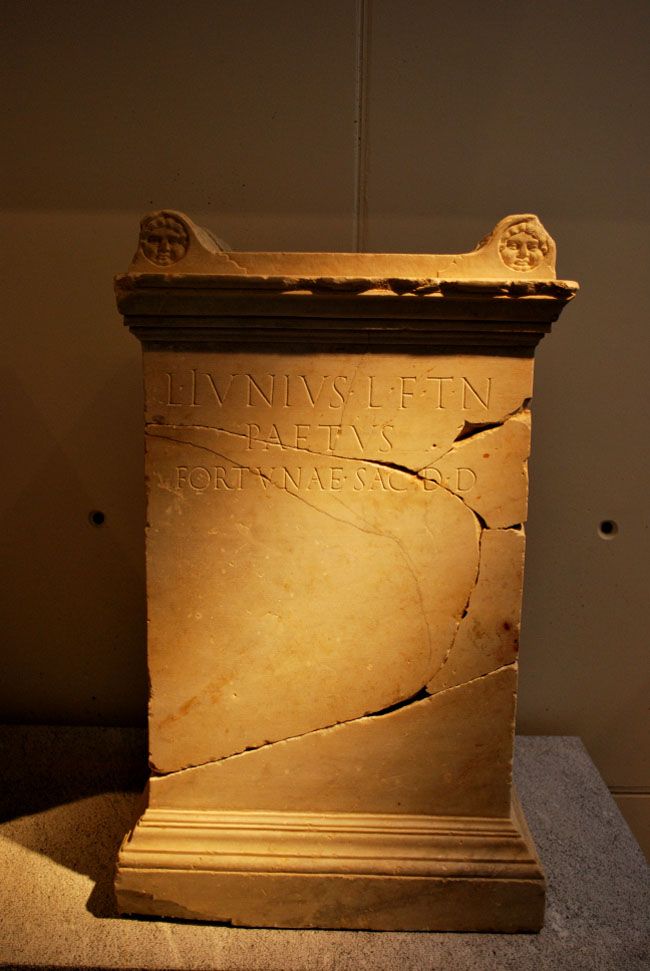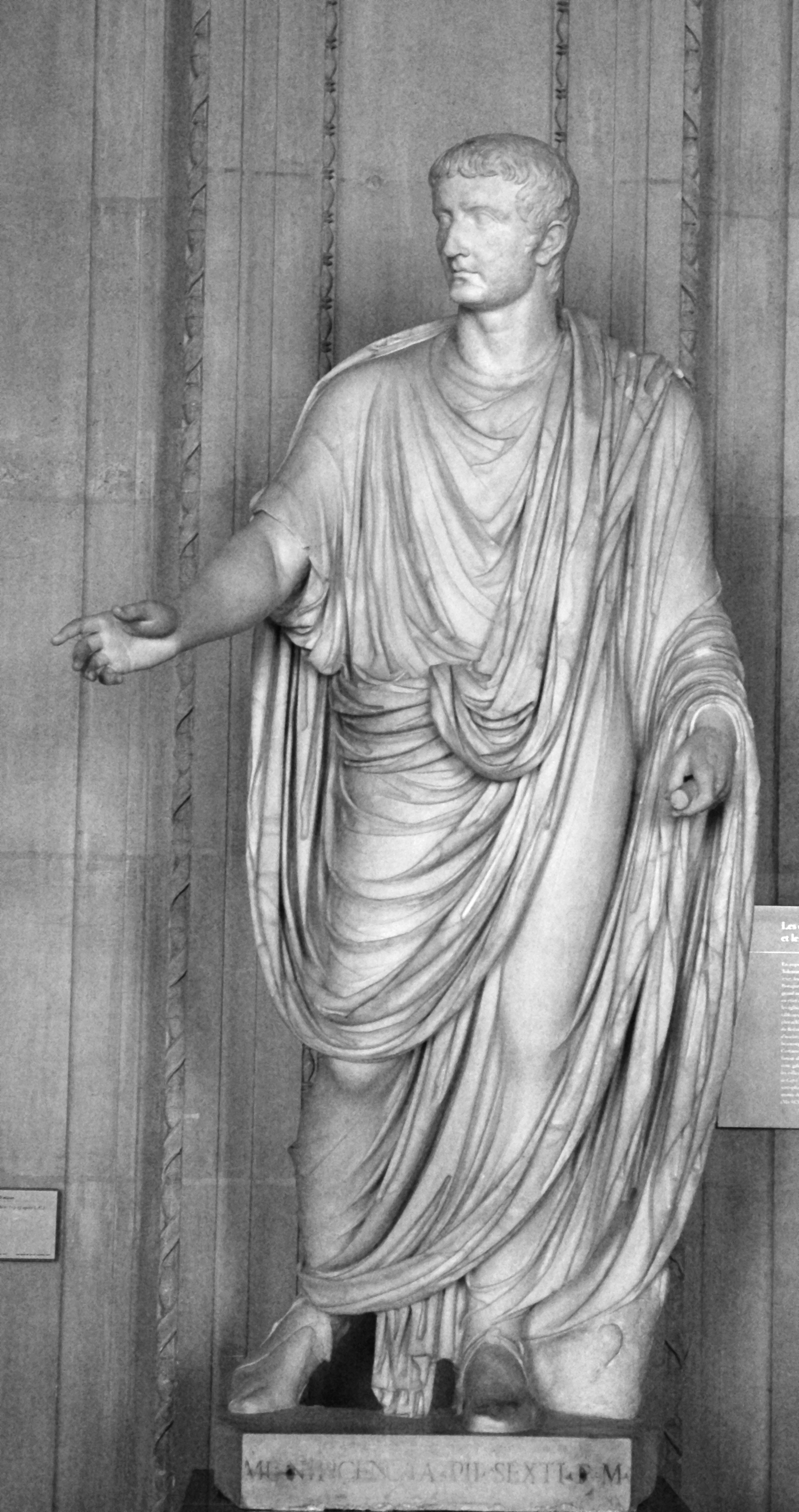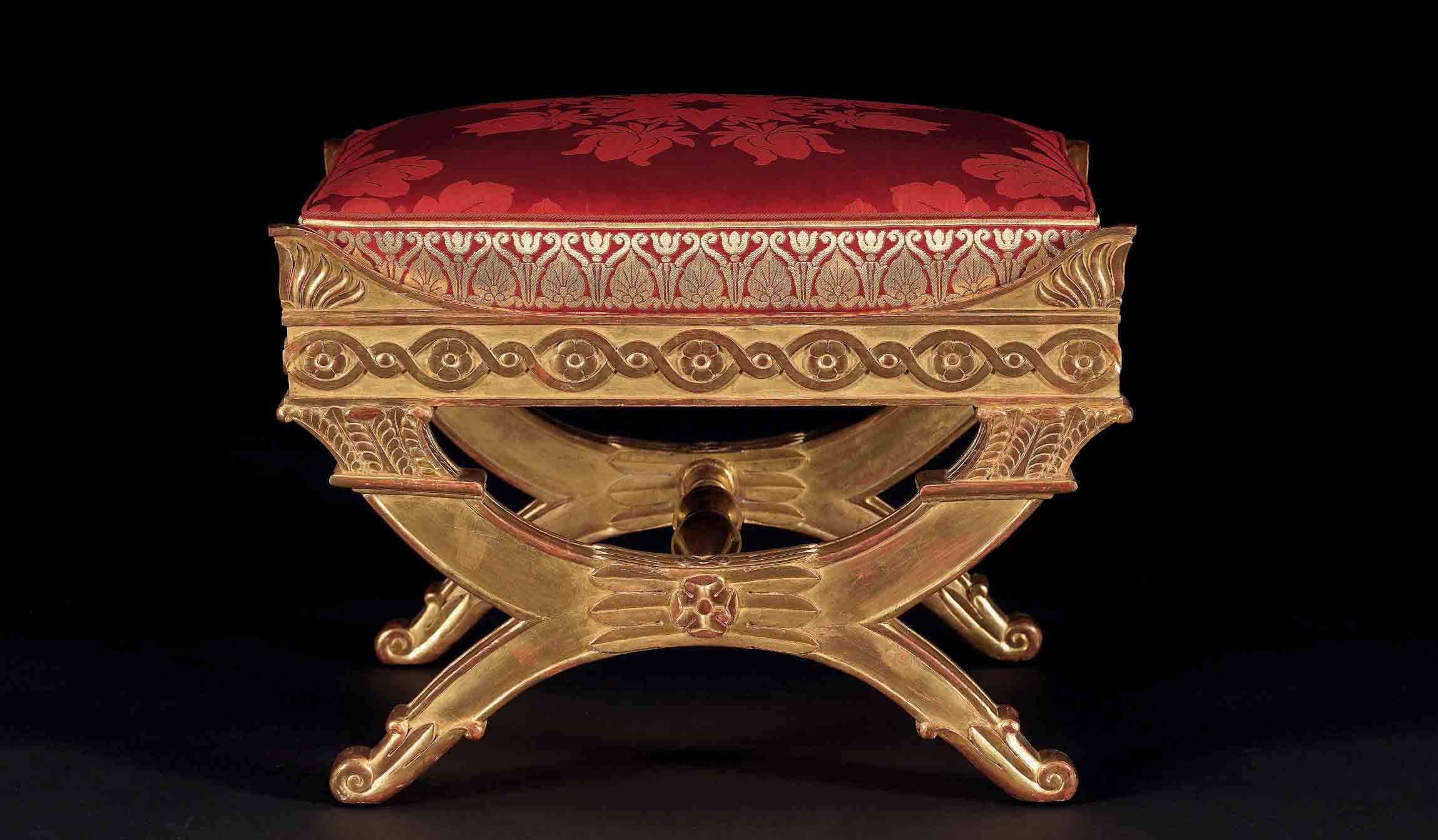|
Aedileship
Aedile ( , , from , "temple edifice") was an elected office of the Roman Republic. Based in Rome, the aediles were responsible for maintenance of public buildings () and regulation of public festivals. They also had powers to enforce public order and duties to ensure the city of Rome was well supplied and its civil infrastructure well maintained, akin to modern local government. There were two pairs of aediles: the first were the "plebeian aediles" (Latin: ''aediles plebis'') and possession of this office was limited to plebeians; the other two were "curule aediles" (Latin: ''aediles curules''), open to both plebeians and patricians, in alternating years. An ''aedilis curulis'' was classified as a '' magister curulis''. The office of the aedilis was generally held by young men intending to follow the ''cursus honorum'' to high political office, traditionally after their quaestorship but before their praetorship. It was not a compulsory part of the cursus, and hence a former quae ... [...More Info...] [...Related Items...] OR: [Wikipedia] [Google] [Baidu] |
Lex Villia Annalis
In Ancient Rome, the ''Lex Villia Annalis'' was a law passed in 180 BC that regulated the minimum age requirements of candidacy for different public offices within the ''cursus honorum''. The law was proposed by Lucius Villius Annalis, a Tribune of the Plebs, after previous debate within the senate pertaining to the age requirements for magistracies. These debates had arisen due to an increase in competition from a rise in new families attempting to gain success and social change within Roman society, which placed pressure on the political sphere. Where previous laws had failed to be passed or were too ambiguous to result in change, the ''Lex Villia Annalis'' has been described as having created a standard for a career in the ''cursus honorum''. Significant debate has arisen over the context and content of the law, given the minimal number of references provided within antiquity. It is questionable as to the level of detail within the law and whether or not it arose out of a f ... [...More Info...] [...Related Items...] OR: [Wikipedia] [Google] [Baidu] |
Cursus Honorum
The , or more colloquially 'ladder of offices'; ) was the sequential order of public offices held by aspiring politicians in the Roman Republic and the early Roman Empire. It was designed for men of senatorial rank. The comprised a mixture of military and political administration posts; the ultimate prize for winning election to each "rung" in the sequence was to become one of the two consuls in a given year. These rules were altered and flagrantly ignored in the course of the last century of the Republic. For example, Gaius Marius held consulships for five years in a row between 104 and 100 BC. He was consul seven times in all, also serving in 107 and 86. Officially presented as opportunities for public service, the offices often became mere opportunities for self-aggrandizement. The constitutional reforms of Sulla between 82 and 79 BC required a ten-year interval before holding the same office again for another term. To have held each office at the youngest pos ... [...More Info...] [...Related Items...] OR: [Wikipedia] [Google] [Baidu] |
Cicero
Marcus Tullius Cicero ( ; ; 3 January 106 BC – 7 December 43 BC) was a Roman statesman, lawyer, scholar, philosopher, orator, writer and Academic skeptic, who tried to uphold optimate principles during the political crises that led to the establishment of the Roman Empire. His extensive writings include treatises on rhetoric, philosophy and politics. He is considered one of Rome's greatest orators and prose stylists and the innovator of what became known as "Ciceronian rhetoric". Cicero was educated in Rome and in Greece. He came from a wealthy municipal family of the Roman equestrian order, and served as consul in 63 BC. He greatly influenced both ancient and modern reception of the Latin language. A substantial part of his work has survived, and he was admired by both ancient and modern authors alike. Cicero adapted the arguments of the chief schools of Hellenistic philosophy in Latin and coined a large portion of Latin philosophical vocabulary via ... [...More Info...] [...Related Items...] OR: [Wikipedia] [Google] [Baidu] |
Roman Magistrate
The Roman magistrates () were elected officials in ancient Rome. During the period of the Roman Kingdom, the King of Rome was the principal executive magistrate.Abbott, 8 His power, in practice, was absolute. He was the chief priest, lawgiver, judge, and the sole commander of the army.Abbott, 8Abbott, 15 When the king died, his power reverted to the Roman Senate, which then chose an Interrex to facilitate the election of a new king. During the transition from the Roman Kingdom to Roman Republic, the constitutional balance of power shifted from the executive (the Roman king) to the Roman Senate. When the Roman Republic was founded in 509 BC, the powers that had been held by the king were transferred to the Roman consuls, of which two were to be elected each year. Magistrates of the republic were elected by the people of Rome, and were each vested with a degree of power called "major powers" (''maior potestas'').Abbott, 151 Dictators had more "major powers" than any other ... [...More Info...] [...Related Items...] OR: [Wikipedia] [Google] [Baidu] |
Julius Caesar
Gaius Julius Caesar (12 or 13 July 100 BC – 15 March 44 BC) was a Roman general and statesman. A member of the First Triumvirate, Caesar led the Roman armies in the Gallic Wars before defeating his political rival Pompey in Caesar's civil war, a civil war. He subsequently became Roman dictator, dictator from 49 BC until Assassination of Julius Caesar, his assassination in 44 BC. Caesar played a critical role in Crisis of the Roman Republic, the events that led to the demise of the Roman Republic and the rise of the Roman Empire. In 60 BC, Caesar, Marcus Licinius Crassus, Crassus, and Pompey formed the First Triumvirate, an informal political alliance that dominated Roman politics for several years. Their attempts to amass political power were opposed by many in the Roman Senate, Senate, among them Cato the Younger with the private support of Cicero. Caesar rose to become one of the most powerful politicians in the Roman Republic through a string of military victories in the G ... [...More Info...] [...Related Items...] OR: [Wikipedia] [Google] [Baidu] |
Tribune Of The Plebs
Tribune of the plebs, tribune of the people or plebeian tribune () was the first office of the Roman Republic, Roman state that was open to the plebs, plebeians, and was, throughout the history of the Republic, the most important check on the power of the Roman Senate and Roman magistrate, magistrates. These tribunes had the power to convene and preside over the ''Plebeian Council, Concilium Plebis'' (people's assembly); to summon the senate; to propose legislation; and to intervene on behalf of plebeians in legal matters; but the most significant power was to veto the actions of the Roman consul, consuls and other magistrates, thus protecting the interests of the plebeians as a class. The tribunes of the plebs were typically found seated on Tribune bench, special benches set up for them in the Roman Forum. The tribunes were sacrosanct, meaning that any assault on their person was punishable by death. In Roman Empire, imperial times, the powers of the tribunate were granted to ... [...More Info...] [...Related Items...] OR: [Wikipedia] [Google] [Baidu] |
Glossary Of Ancient Roman Religion
The vocabulary of ancient Roman religion was highly specialized. Its study affords important information about the religion, traditions and beliefs of the ancient Romans. This legacy is conspicuous in European cultural history in its influence on later juridical and religious vocabulary in Europe, particularly of the Christian Church. This glossary provides explanations of concepts as they were expressed in Latin pertaining to Religion in ancient Rome, religious practices and beliefs, with links to articles on major topics such as priesthoods, forms of divination, and rituals. For theonyms, or the names and epithets of gods, see List of Roman deities. For public religious holidays, see Roman festivals. For temples see the List of Ancient Roman temples. Individual landmarks of religious Topography of ancient Rome, topography in ancient Rome are not included in this list; see Roman temple. __NOTOC__ Glossary A abominari The verb ''abominari'' ("to avert an omen", from ''ab-'', ... [...More Info...] [...Related Items...] OR: [Wikipedia] [Google] [Baidu] |
Second Punic War
The Second Punic War (218 to 201 BC) was the second of Punic Wars, three wars fought between Ancient Carthage, Carthage and Roman Republic, Rome, the two main powers of the western Mediterranean Basin, Mediterranean in the 3rd century BC. For 17 years the two states struggled for supremacy, primarily in Roman Italy, Italy and Iberia, but also on the islands of Sicily and Sardinia and, towards the end of the war, in North Africa. After immense materiel and human losses on both sides, the Carthaginians were once again defeated. Macedonia (ancient kingdom), Macedonia, Kingdom of Syracuse, Syracuse and several Numidians, Numidian kingdoms were drawn into the fighting, and Celtiberians, Iberian and Gauls, Gallic forces fought on both sides. There were three main Theater (military), military theatres during the war: Italy, where Hannibal defeated the Roman legions repeatedly, with occasional subsidiary campaigns in Sicily, Sardinia and Greece; Iberia, where Hasdrubal (Barcid), Hasdru ... [...More Info...] [...Related Items...] OR: [Wikipedia] [Google] [Baidu] |
Tabula Heracleensis
The Heraclean Tablets (in older texts, the ''Heraclean Table(s)''; Latin-language, Lat.''Tabulae Heracleenses'') are bronze tablets found a short distance from the site of Heraclea Lucania, in the direction of Metapontum. They are significant for the study of Roman Law. Background As a consequence of its having accepted Ancient Rome, Roman citizenship in 89 BCE, Heraclea became a municipium, and the ''Tabulae Heracleenses'' contain a long Latin inscription relating to the municipal regulations of Heraclea, engraved on two tablets of bronze, on the back of which is a long Greek inscription of earlier date, probably the 3rd century BC, defining the boundaries of lands belonging to various temples. This document is a major authority for the municipal law of ancient Italy. Scholarship traditionally identified the inscription on the tablets with the ''Lex Iulia Municipalis'', a law issued in 45 BCE for the regulation of the municipal institutions of towns throughout Italy. It is now wi ... [...More Info...] [...Related Items...] OR: [Wikipedia] [Google] [Baidu] |
Toga
The toga (, ), a distinctive garment of Ancient Rome, was a roughly semicircular cloth, between in length, draped over the shoulders and around the body. It was usually woven from white wool, and was worn over a tunic. In Roman historical tradition, it is said to have been the favored dress of Romulus, Rome's founder; it was also thought to have originally been worn by both sexes, and by the citizen-military. As Roman women gradually adopted the stola, the toga was recognized as formal wear for male Roman citizens. Women found guilty of adultery and women engaged in prostitution might have provided the main exceptions to this rule.. The type of toga worn reflected a citizen's rank in the civil hierarchy. Various laws and customs restricted its use to citizens, who were required to wear it for public festivals and civic duties. From its probable beginnings as a simple, practical work-garment, the toga became more voluminous, complex, and costly, increasingly unsuited to a ... [...More Info...] [...Related Items...] OR: [Wikipedia] [Google] [Baidu] |
Curule Seat
A curule seat is a design of a (usually) foldable and transportable chair noted for its uses in Ancient Rome and Europe through to the 20th century. Its status in early Rome as a symbol of political or military power carried over to other civilizations, as it was also used in this capacity by kings in Europe, Napoleon, and others. History Ancient Rome In the Roman Republic and the Roman Empire, the curule chair (''sella curulis'', supposedly from ''currus'', "chariot") was the seat upon which magistrates holding ''imperium'' were entitled to sit. This includes Roman Dictator, dictators, ''Magister equitum, magistri equitum'', Roman consul, consuls, praetors, ''curule aediles'', and the promagistrates, temporary or ''de facto'' holders of such offices. Additionally, the Roman censor, censors and the flamen of Jupiter (god), Jupiter (Flamen Dialis) were also allowed to sit on a curule seat, though these positions did not hold ''imperium''. Titus Livius, Livy writes that the thr ... [...More Info...] [...Related Items...] OR: [Wikipedia] [Google] [Baidu] |








